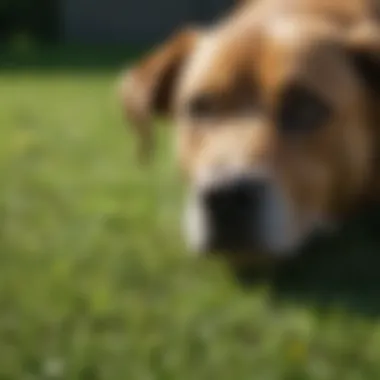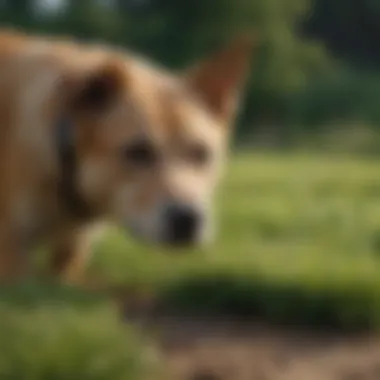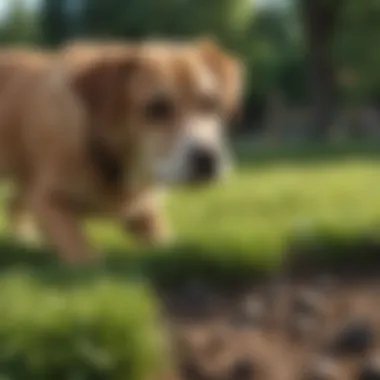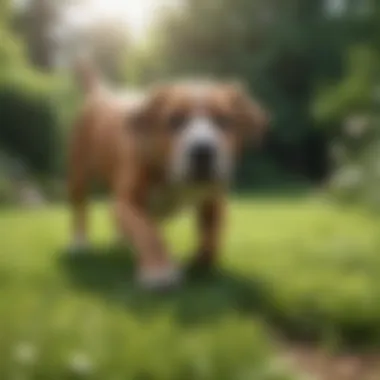Repairing Lawn Damage from Dog Urine: Effective Strategies


Intro
Lawn damage from dog urine is a common problem for pet owners. Understanding the impact of dog urine on grass is crucial for restoring your lawn's health. This section will highlight the core aspects of lawn restoration, including the implications of urinary damage, commonly affected grass types, and effective repair strategies. Grasping these elements is vital for maintaining a healthy lawn while ensuring your dog's comfort and freedom to play outdoors.
Implications of Dog Urine on Lawns
Dog urine, primarily composed of nitrogen, can burn and damage grass. The concentration of this nitrogen is higher than typical soil nutrients, which leads to a toxic reaction. As a result, grass can appear yellow or brown in patches after exposure.
Affected Grass Types
Certain grass species are more susceptible to damage. For example, Kentucky bluegrass, fescue, and Bermuda grass are often reported to show signs of deterioration. Conversely, Zoysia grass tends to recover better from such damage due to its growth patterns. Understanding which grasses to choose can be crucial for lawn maintenance.
Repair Strategies
To effectively address lawn damage caused by dog urine, proactive and reactive strategies are essential.
Immediate Actions
- Watering: The first step in damage control is to dilute the concentration of urine. Watering the affected area thoroughly will help spread the nitrogen out and reduce its harmful effects.
- Assess and Reseed: Evaluate the extent of the damage. If the grass is dead, reseeding in the spring or fall can promote new growth. Choosing a grass type suited to your specific climate is critical for successful establishment.
Long-Term Maintenance
- Limit Urine Exposure: Training your dogs to use a specific area can minimize lawn damage. Using gravel or mulch in designated spots can also be beneficial.
- Fertilization: A balanced fertilizer can help boost overall grass health and improve resilience against future damage.
- Soil Testing: Regular soil testing can provide insight into nutrient levels and pH balance, allowing for better lawn care decisions.
"Effective management of dog urine damage requires an understanding of both immediate and long-term strategies."
Preventative Measures
Taking steps to prevent lawn damage can save pet owners time and effort.
- Create a Designated Bathroom Area: Training can help contain urine damage while keeping the main lawn intact.
- Choose the Right Grass: Selecting resilient grass varieties is beneficial in areas frequented by pets.
- Regular Lawn Care: Consistent mowing, watering, and fertilization help keep grass healthy and ready to withstand stress from dog urine.
Preface
Repairing lawn damage from dog urine is a matter of interest for many pet owners. This topic holds significance because lawns not only improve aesthetic appeal but also provide an essential space for pets to play and rest. Understanding the effects of dog urine on grass is crucial for maintaining lawn health while ensuring pets have a comfortable environment. Effective strategies exist that can help to mitigate damage, allowing owners to foster vibrant, resilient lawns.
When addressing lawn damage, it is important to identify the unique challenges posed by dog urine. An understanding of grass types and their response to urine can facilitate better recovery protocols. Additionally, we will delve into preventative measures that can be put in place to safeguard lawns while maintaining the happiness of pets. This article will provide informative insights and practical solutions, helping readers to tackle lawn issues efficiently.
The Impact of Dog Urine on Grass
Dog urine can have a notable impact on grass health. It contains nitrogen and other compounds that can lead to lawn burn. This damage manifests as yellow or brown patches, which are often prominent in otherwise green spaces. Additionally, the high concentration of nitrogen can overwhelm certain grass species, causing them to react negatively.
Grasses like Kentucky bluegrass may be more susceptible to damage compared to tougher varieties. The circular or patchy patterns created by urine spots can detract from the overall uniformity of the lawn. Understanding this impact helps pet owners recognize signs of damage early and take prompt action.


Understanding the Problem
Understanding the problem requires recognizing both the chemical composition of dog urine and its effects on different types of grasses. The primary issue stems from the concentration of nitrogen, which is beneficial in moderation but can become harmful at high levels. Accompanying elements, such as salts and urea, can also contribute to lawn deterioration.
Identifying the degree of damage is essential in formulating a recovery plan. Owners should assess whether the grass is simply experiencing a temporary shock or if significant long-term damage has occurred. This evaluation can guide immediate actions and inform more lasting recovery techniques. Being aware of these details positions pet owners to manage their lawns and pets with greater efficacy.
Chemical Composition of Dog Urine
Understanding the chemical composition of dog urine is essential for comprehending its impact on lawn health. Dog urine is primarily composed of water, but it also contains notable nitrogen, urea, creatinine, and various salts. Each of these elements interacts differently with grass, leading to varying degrees of damage to the lawn. Recognizing these components can assist pet owners in implementing effective repair strategies and preventative measures. This section will delve into the specific substances found in dog urine and their consequences for grassy landscapes.
Nitrogen Levels and Lawn Effects
Nitrogen is a significant component of dog urine. While nitrogen is vital for plant growth, excessive amounts can lead to damage instead of promoting health. When dog urine is deposited on grass, the concentration of nitrogen spikes in that localized area. This rapid influx can result in a phenomenon known as "burning." The grass often turns yellow or brown, as it becomes unable to absorb all the nitrogen at once. Furthermore, the high nitrogen concentration can create imbalances in the soil, making it less hospitable for grass and beneficial microbes.
To manage nitrogen levels and combat damage, homeowners should consider several strategies:
- Dilution with Water: Immediately watering the spot where urine has been deposited can help dilute the nitrogen. This will reduce the concentration that grass is exposed to.
- Soil Testing: Conducting soil tests will reveal the nitrogen levels and overall health of the lawn. Based on this data, appropriate adjustments can be made to fertilizer use.
- Regular Lawn Maintenance: Keeping the lawn well-fed with balanced fertilizers that contain adequate but not excessive nitrogen levels can normalize the soil's nutrient profile.
Other Constituents and Their Impact
In addition to nitrogen, dog urine contains urea, creatinine, and various salts. The presence of urea can also cause lawn damage, as it can transform into ammonia under specific conditions. Ammonia can be toxic to grass, contributing further to the browning effect.
Salts found in urine can affect the soil's pH levels. High salt concentrations can lead to soil salinity, creating a challenging environment for grass growth. This can hinder the grass's ability to absorb water and negatively impact its overall resilience.
To mitigate these issues, homeowners might consider these actions:
- Incorporating Organic Matter: Adding organic matter such as compost can improve soil structure. This promotes better drainage and reduces salt concentration.
- Choosing Grass Varieties Wisely: Some grass types are more resistant to urine damage. Selecting species based on the specific environment can yield better long-term results.
- Establishing a Lawn Care Routine: Regular aeration and overseeding may help rehabilitate affected areas, promoting a faster recovery.
"Understanding the components of dog urine allows pet owners to take proactive steps in maintaining a healthy lawn."
By reflecting on the chemical makeup of dog urine and its effects, owners can create effective repair strategies. This understanding facilitates informed decisions that benefit both the lawn and the pet.
Identifying Affected Grass Types
Understanding which grass types are affected by dog urine is crucial for effective lawn repair. Different grasses respond to urine exposure differently. Some grass types exhibit resilience while others sustain significant damage. Recognizing the specific grass type in your lawn aids in selecting the correct repair techniques. Moreover, understanding how dog urine affects various grass species can inform your approach to lawn management, ensuring a healthy and vibrant turf.
Cool-Season vs. Warm-Season Grasses
Cool-season grasses, such as Kentucky bluegrass and fescue, thrive in northern climates. These grasses usually experience growth in cooler temperatures, making them susceptible to nitrogen overload from dog urine in the spring and fall. The excess nitrogen can cause browning or patchy areas. Conversely, warm-season grasses, like Bermuda and zoysia, flourish in southern regions. These grasses tend to be more tolerant of dog urine exposure, but they can still exhibit signs of stress if the application is excessive. Knowing whether your lawn consists of cool-season or warm-season grasses allows for tailored care strategies that maximize recovery.
Assessing Lawn Damage Severity
Evaluating the extent of damage is essential for implementing the right repair strategies. Signs of damage can vary from yellowing grass to brown patches. Start by inspecting the lawn visually. Look for discoloration or areas that appear to be wilting. More serious issues may require a closer examination of the soil and grass roots.
- Mild Damage: Discoloration but grass remains intact and resilient.
- Moderate Damage: Patches of dead grass mixed with healthy areas, indicating more substantial stress.
- Severe Damage: Large sections of dead grass with roots compromised, necessitating immediate intervention.


Identifying the severity informs decisions about whether immediate remedies, such as watering or soil amendment, or long-term recovery methods, such as reseeding or over-seeding, are required.
Repair Techniques for Damaged Lawns
Repair techniques play a crucial role in restoring lawns affected by dog urine. This section delves into both immediate and long-term strategies, addressing the symptoms and underlying issues caused by the damage.
It's important to recognize that unless proper repair techniques are applied, areas affected by dog urine may remain bare and unattractive for extended periods. The significance of effective repair lies in not just aesthetic improvement, but also in promoting healthier grass growth and enhanced soil quality. Addressing these damage effects will lessen overall maintenance time and costs in the future.
Immediate Remedies to Minimize Damage
Immediate action is key when it comes to mitigating lawn damage from dog urine. One basic step is to water the affected area thoroughly right after your dog urinates. This dilutes the urine’s concentration, reducing its harmful effects significantly. It’s a simple yet effective intervention that may save your lawn in the early stages of damage.
Another method is to apply a pet-friendly neutralizing product to affected spots. Several products are designed specifically for this purpose and can help restore balance in the soil. Be cautious and read labels carefully to choose options that won’t harm your grass further.
Long-Term Lawn Recovery Strategies
For a more sustained recovery, long-term strategies are invaluable. These strategies involve various methods to restore the lawn’s health while minimizing future occurrences of damage.
Overseeding Techniques
Overseeding is a popular recovery method as it introduces new grass seed into existing grass. This technique helps to establish a thicker lawn that can better withstand dog urine’s effects. One key characteristic of overseeding is that it can fill in bare patches without the need for extensive soil disruption. This is particularly beneficial because it minimizes disturbance to the existing root system and soil structure.
However, overseeding requires specific timing, generally in the fall or spring, depending on grass type. The main advantage is that it leads to a resilient lawn that can recover from minor damages. Nevertheless, a downside may include ongoing maintenance to ensure new seeds germinate properly.
Reseeding with Resistant Varieties
Another effective technique is reseeding with grass varieties that show more resistance to urine damage, such as Kentucky bluegrass or tall fescue. These grass types have demonstrated a stronger ability to handle the high nitrogen levels found in dog urine. Their resilience is a key characteristic that makes them a beneficial choice for lawns frequented by dogs.
When planning your reseeding, it’s essential to match the resistant varieties with your existing grass to ensure compatibility. This method results in a healthier lawn and can reduce the risk of future damage. A potential drawback is the necessity of changing seed types, which may initially create an inconsistency in lawn appearance until the new grass establishes.
Enhancing Soil Quality
Improving soil quality is another critical aspect of long-term recovery strategies. Healthy soil can better absorb and breakdown dog urine, preventing damage. Amending the soil with organic materials such as compost can increase its nutrient content and microbial activity, promoting a better recovery.
Furthermore, soil testing can identify specific nutrient deficiencies that can be rectified through proper fertilization. This aspect of enhancing soil quality contributes significantly to the overall goal of establishing a robust lawn system. A unique feature is that improved soil not only aids in recovery but also fosters long-term lawn health. The potential downside is the time commitment and possible costs associated with regular soil amendments.
In summary, effective repair techniques for lawns damaged by dog urine require immediate actions and strategic long-term plans. Proper knowledge of methods such as overseeding, reseeding resistant varieties, and enhancing soil quality can transform an affected lawn into a vibrant and healthy environment.
Watering and Fertilization Practices
Watering and fertilization are crucial elements in maintaining a healthy lawn, especially after damage from dog urine. Understanding how to properly manage these practices can make a significant difference in the recovery and overall resilience of your grass. The right amount of water encourages growth and helps dilute the harmful chemicals found in dog urine, while appropriate fertilization supports lawn recovery by providing essential nutrients.
The Role of Watering in Lawn Health
Watering plays an essential role in lawn health. It not only helps the grass survive but also supports recovery from damage. When dog urine affects your lawn, it can lead to dead patches or discoloration. Here are some key aspects of watering:


- Dilution of Urine: Immediately watering the affected area can dilute the nitrogen and salts present in dog urine, reducing the likelihood of further damage.
- Promoting Root Growth: Regular watering encourages strong root development. This is vital for your grass to withstand different environmental stresses, including urine exposure.
- Avoiding Overwatering: While watering is important, overwatering can lead to fungal issues and root rot. It's important to find a balance. Ideally, grass should receive about one inch of water per week, including rainfall, during growing seasons.
- Watering Techniques: Water deeply and infrequently to encourage deeper root systems. Early morning is usually the best time to water, as this minimizes evaporation and reduces the risk of disease.
Selecting Proper Fertilizers
Fertilizers play a fundamental role in the recovery and maintenance of a healthy lawn. After a dog has urinated in areas of your yard, selecting the right type of fertilizer becomes crucial. Proper fertilization can help balance the lawn and compensate for nutrient loss. Consider these factors when selecting fertilizers:
- Nutrient Balance: Look for fertilizers that have a good N-P-K ratio (Nitrogen-Phosphorus-Potassium). A balanced ratio helps to restore nutrients lost due to urine while promoting overall lawn health.
- Slow-Release Formulas: Opt for slow-release fertilizers as they provide nutrients over an extended period. This method reduces the risk of nutrient runoff and provides a steadier supply of nutrition to your lawn.
- Organic Options: If you're concerned about chemicals, consider organic fertilizers. They contribute to soil health and improve microbial activity, which supports grass recovery along with broader ecosystem sustainability.
- Testing Soil: Before applying fertilizer, testing your soil can identify existing nutrient levels and deficiencies. This approach ensures that you are adding only what is needed, preventing over-fertilization which can lead to more strain on your grass.
"Proper watering and fertilization not only help repair lawn damage but also create a lush, healthy environment for pets and humans alike."
In summary, effective watering and selecting appropriate fertilizers are critical strategies for repairing lawn damage caused by dog urine. Keeping these practices in mind can significantly aid in restoring the luster of your lawn.
Preventative Measures for Pet Owners
The management of dog urine-related damage is not solely about responding to existing problems. Preventative measures play a vital role in ensuring that both pets and lawns coexist harmoniously. Taking proactive steps can mitigate the risk of damage while enhancing the overall health of the grass. Understanding these measures enables pet owners to enjoy a thriving lawn with minimal complications.
Training Your Dog for Lawn Etiquette
One of the most effective strategies is to train your dog to use the yard responsibly. This involves establishing clear boundaries and reinforcing good behavior. Training reinforces the idea that some areas of the yard are off-limits for urination. This strategy requires consistency and patience.
- Positive Reinforcement: Use treats and praise when your dog follows the designated rules to create a positive association with desired behaviors.
- Routine Establishment: Develop a regular schedule for outdoor play and bathroom breaks, making it easier to manage where they relieve themselves.
- On-leash Training: In the early stages, keep your dog on a leash to guide them to preferred spots. Gradually increase their freedom as they learn where to go.
Training may take time, but with persistence, many pet owners report significant improvements in lawn conditions. By instilling proper habits in their dogs, pet owners can protect their grassy areas.
Creating Designated Urination Areas
Creating a designated area for urination is another effective approach. This strategy not only limits damage to the main lawn but also serves as a consistent place for dogs to relieve themselves. To implement this:
- Select a Suitable Location: Choose an area with durable grasses or ground cover that can withstand urination. Avoid flower beds or areas with delicate plants.
- Mark the Area: Make the designated area prominent. You can use flags, rocks, or garden decorations to visually guide dogs.|
- Encourage Usage: Direct your dog toward this area after meals and play sessions. Use rewards to encourage them to go in the designated spots.
- Maintenance: Keep this area clean and well-maintained. Regular maintenance prevents odor and makes it a pleasant spot for your dog.
By establishing these strategies, pet owners can effectively manage their dogs' behavior while promoting a healthy lawn. Preventative measures create a more enjoyable outdoor space for both pets and people.
Epilogue
In this article, we have examined various aspects of lawn care concerning damage caused by dog urine. Understanding the problem is essential for pet owners to mitigate the negative impact on their lawns. By summarizing effective lawn care practices, we can emphasize the importance of timely and appropriate action. This involves recognizing the signs of damage, employing suitable repair methods, and implementing preventative measures.
Summarizing Effective Lawn Care Practices
Effective lawn care practices begin with a clear understanding of the specific needs of your lawn. Regularly assessing the health of your grass can aid in identifying areas impacted by urine. Key practices include:
- Regular watering: Deep watering can help flush out nitrogen levels from urine, promoting recovery. Efficient watering schedules will improve overall lawn health.
- Soil quality management: Enhancing soil quality by incorporating organic matter will foster microbial activity, which aids in breaking down toxins from urine.
- Choosing resistant grass varieties: Some grass types, such as tall fescue, are more resilient to urine damage. Reseeding with these varieties can provide long-term benefits.
Keeping your lawn well-groomed, cutting it at the right height, and maintaining proper fertilization practices will also lead to a robust lawn capable of withstanding occasional damage.
Encouraging Sustainable Pet Ownership
Sustainable pet ownership plays a crucial role in minimizing environmental damage while ensuring pets are happy. Encouraging responsible pet ownership includes:
- Training your dog for appropriate urination habits: Positive reinforcement techniques can help direct dogs to specific areas of the yard, reducing the impact on other grass.
- Creating designated urination areas: Establishing a place in the yard for your dog to urinate can protect the majority of the lawn from concentrated damage. Consider using gravel or mulch in these areas to facilitate drainage.
- Engaging with local communities: Pet owners can benefit from sharing experiences and tips regarding lawn care and pet behavior. Online forums, such as Reddit or Facebook groups, can serve as valuable resources for exchanging ideas and solutions.
Every pet owner must consider their pet's behavior and its impact on the environment, aiming for a balance between maintaining a healthy lawn and ensuring their pet's comfort.







